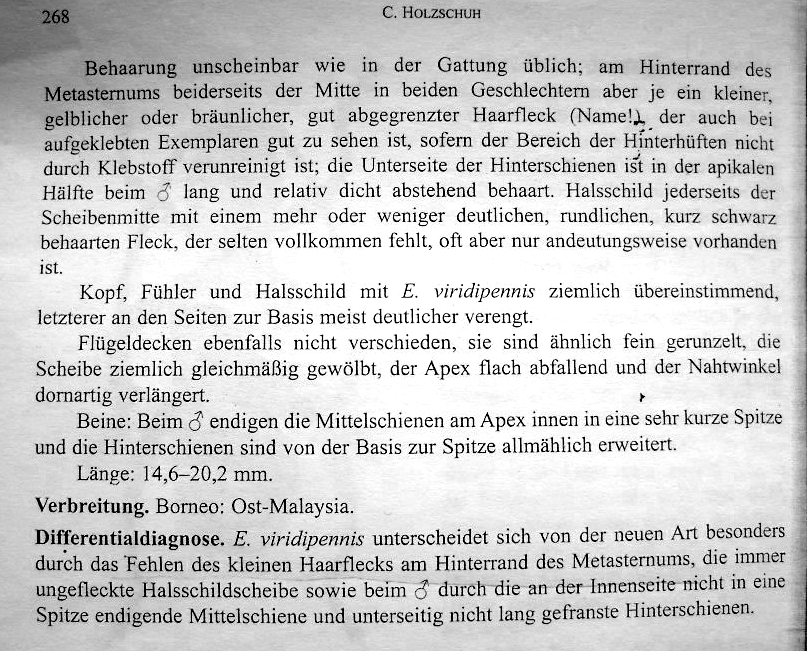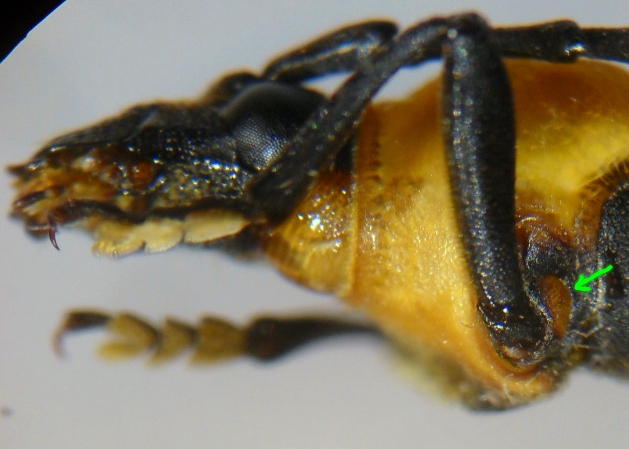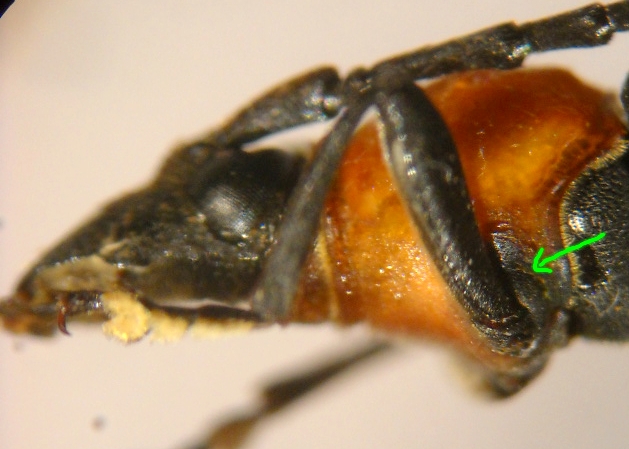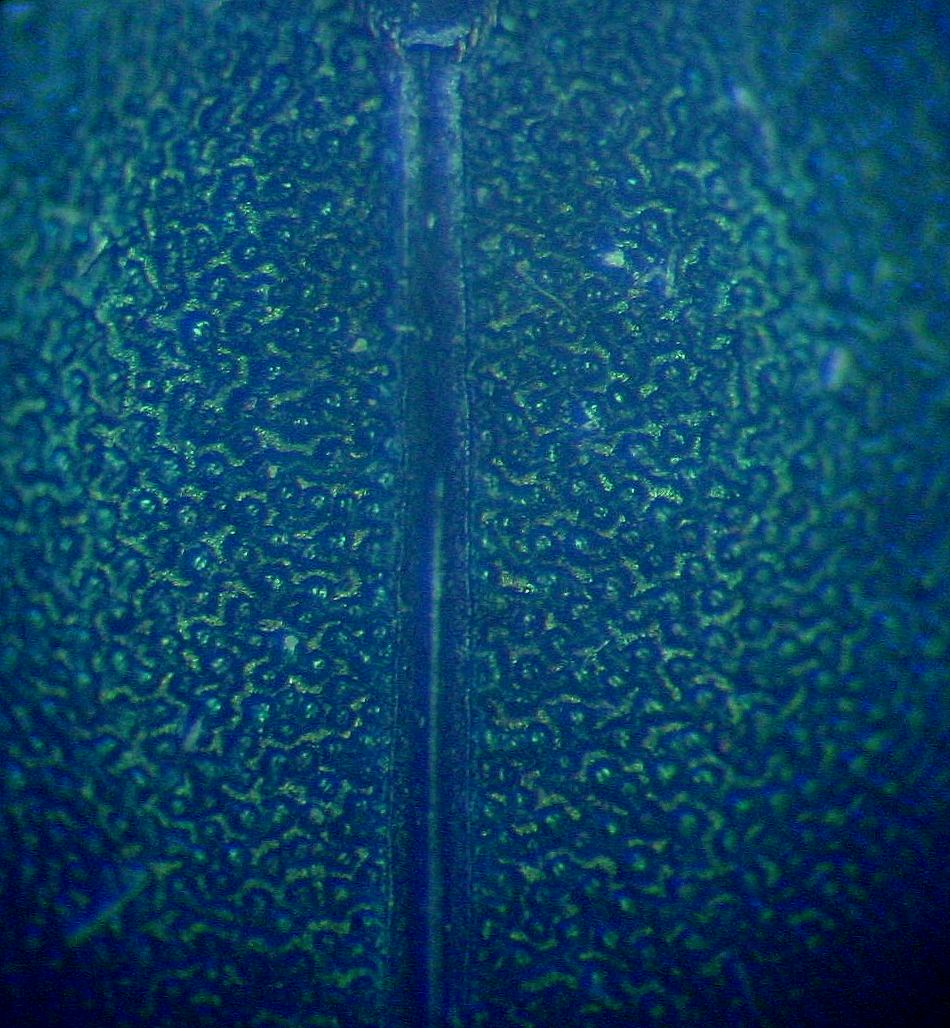| T O P I C R E V I E W |
| Andre |
Posted - 10/03/2013 : 01:09:37

38.61áKB
Borneo, Trus Madi,
Female, 17 mm. |
| 15 L A T E S T R E P L I E S (Newest First) |
| dryobius |
Posted - 03/10/2017 : 12:52:39
I had the opportunity to study numerous green Erythrus from W. Kalimantan recently.. I also provided numerous examples to Holzschuh. He has not finalized his study yet, but the only species I have definitely identified are E. gilvellus and E. viridipennis.
These two species are readily separated by the texture of their elytra. R. gilvellus is, what I see, extremely finely and distinctly rugose. With a hand lens, this texture is quite obvious. The pronotum of E. gilvellus is unicolorous, but is slightly tuberculate. The pronotum of viridipennis is much smoother. E. viridipennis has, occasionally, some bluish color apically or nearly completely covering the elytra.
E. crinitoguttatus and E. viridipennis are very similar in the texture of the elytra. The easiest way for me to separate them is by examining the ventral surface and looking for a small area of what pubescence by the rear coxa. Sometimes, E. crinitoguttatus has two small black, round, spots on the pronotum and none of the other green Eyrthrus have this feature as far as I know.
For many of the black and red Erythrus, the location of red and black is very problematical. I have specimens of E. magnus with black heads. E. ignitus males and females have somewhat different patterns on the elytra.
I have about 5 species from Borneo which may be new. So, there are probably many still waiting to be discovered. |
| cerambyphil |
Posted - 27/03/2017 : 20:23:27
Thank you Dan for your answer.
Indeed, I have a small set of 6 insects with the same data of this indeterminate species.
|
| dryobius |
Posted - 27/03/2017 : 16:49:05
There has not been any new "green" Erthrus described. For me, it is very possible that you have a new species.
I have one specimen from Sabah that looks like a hybrid between a green and red species. It has a most unusual color.
I prefer not to speculate on any determinations for this genus, especially from a photograph. Holzschuh still plans on describing more. I have several unique singletons, too. Undoubtedly, there are more waiting to be discovered. Some species are too variable to identify unless you have a series from one place collected on the same date where it is likely that they are the same species.
As with any species that is cryptically colored or a mimic of some foul tasting hemipteran or other poisonous insect... there tends to be more variability than normal. |
| Gontran |
Posted - 27/03/2017 : 15:41:19
Thank you all. I will certainly use these informations, pictures and key to have a better and closer look at those green Erythrus. Even with specimens of E. viridipennis determined by Holzschuh and one paratype of the other two species, it is difficult to separate them. All my crinitoguttatus have those two black spots. But I am not so sure now about all the other determinations. Many have a (?). |
| cerambyphil |
Posted - 27/03/2017 : 10:45:47
Dan,
Do you know if a new green species of Erythrus was described since 2013?
I've the feeling of having 4 different species in my collection.
- Erythrus viridipennis with entire red pronotum and reticulated elytral surface;
- Erythrus crinitoguttatus with a pronotal black spot at the external side of the procoxae, one hairy yellowish/brownisk spot one each side of the median line of the base of the metasternum and a coarsely punctuated elytra;
- Erythrus gilvellus with partially yellow forecoxae, black pronotal area at the external side of the procoxae and reticulated elytral surface;
- Erythrus nov. sp.? with anterior coxae yellow on its front side, black pronotal area on the sides and at the rear of the procoxae and coarsely elytral puncture.
This species is located in West Kalimantan, Mt Bawang and looks like crinitoguttatus shape. |
| dryobius |
Posted - 08/04/2013 : 22:40:25
In my series of green Erythrus from Sabah, I find specimens of all three species with identically colored pronotum and elytra. Unfortunately, you can not separate any of them by a quick examination.
The "true character" which you mentioned: the patch of pubescence on the posterior margin of the metasternum, is a VERY SMALL patch !! It is there to see, but it is also easy to miss.
But, even Holzschuh told me that his first clue that there was more than one species was when he noticed the differences in the microsculpture of the elytra. I presume he was using about 20x magnification. |
| Francesco |
Posted - 08/04/2013 : 19:10:08

215.35 KB
And this Erythrus gilvellus Holzschuh, 2006
Same data. |
| Francesco |
Posted - 08/04/2013 : 19:05:25

217.23 KB
In order to complete the topic, this is a pair of Erythrus crinitoguttatus Holzschuh, 2006.
Borneo, Trus Madi, V.2011 |
| Francesco |
Posted - 08/04/2013 : 19:01:12

502.83áKB
This is Holzschuh's original description of E. crinitoguttatus.
Actually, the missing of points is a character differentiating E. viridipennis (as usual, Holzuschuh's differential diagnoses are inverted: he differentiate the old species instead to differentiate the new one). But some E. crinitoguttatus could miss the black points, you are right.
However, nothing is written about the elytral puncturing.
The true character is the presence of a spot of yellowish or brownish hairs at both sides of the posterior margin of the metasternum. |
| dryobius |
Posted - 07/04/2013 : 20:24:12
The black spots on the pronotum are only present on a few of my paratypes of E. crinitoguttatus.
You can not rely on that simple character.
Does Holzschuh's description say that "all" crinitoguttatus have black spots on the pronotum? |
| Andre |
Posted - 07/04/2013 : 12:58:07
Hallo Francesco, Thank you for this Key.
The procoxa by my Spec. is black. Than is it E. viridipennis. Top! |
| Francesco |
Posted - 07/04/2013 : 12:17:32
In order to separate the three green Erythrus-species, you should use this simple key:
1. Procoxae yellow... gilvellus
-. Procoxae black.... 2

Erythrus gilvellus
2. Pronotum (red) unicolor... viridipennis
-. Pronotum with two minutes black spots... crinitoguttatus

Erythrus viridipennis/crinitoguttatus |
| Andre |
Posted - 13/03/2013 : 18:58:57
Hallo Dan, a greater magnification for this is not possible with my equipment.[

192.57áKB |
| dryobius |
Posted - 11/03/2013 : 06:21:21
This is E. viridipennis Gahan.
But the differences between the 3 green Erythrus are easier to see if you had an even greater magnification of the punctation on the elytra.
|
| Andre |
Posted - 10/03/2013 : 15:01:57
Hallo Dan, here a picture from Pronotum/elytra.

217.47áKB |


